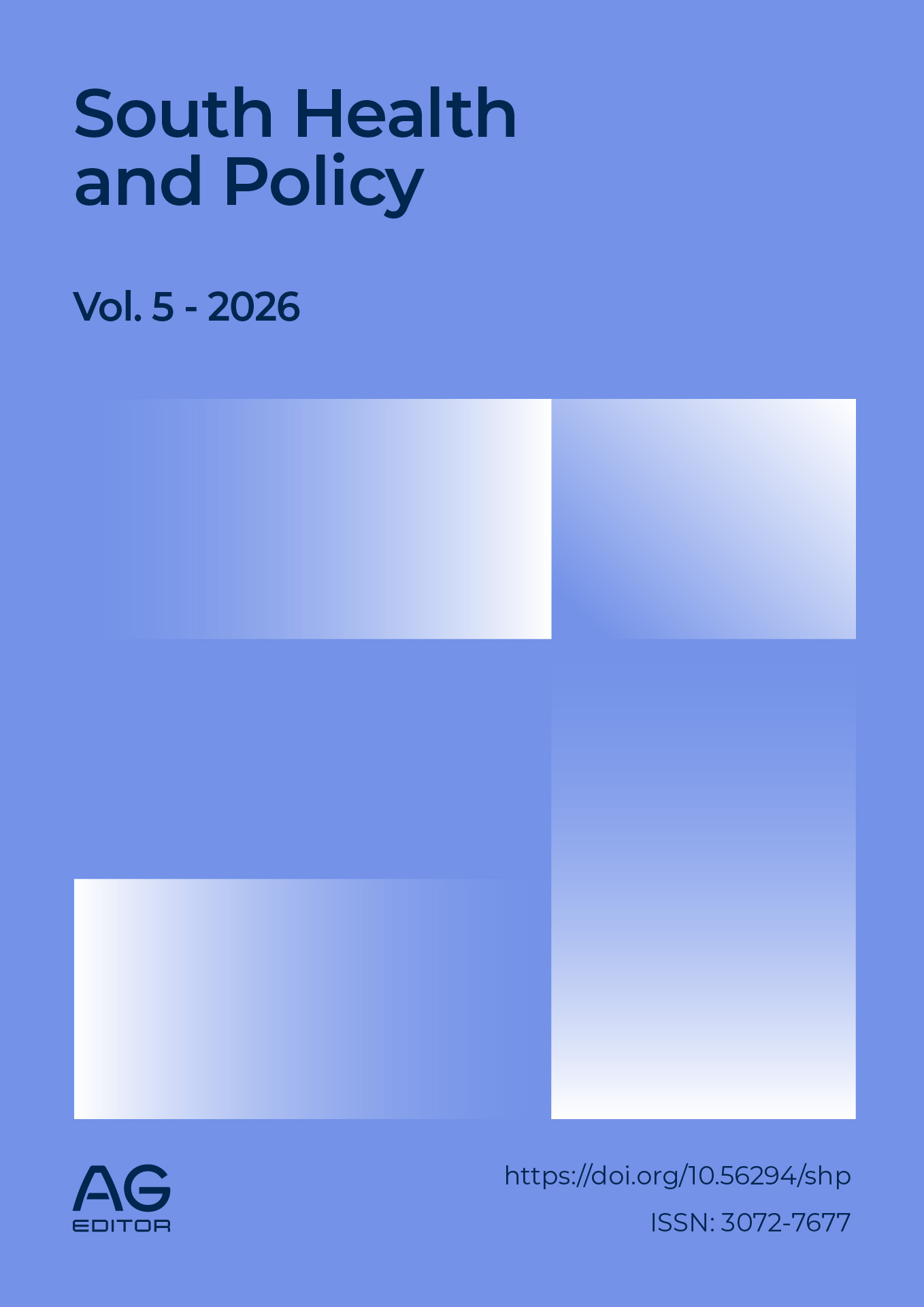Prevalence of risk factors for Type II Diabetes Mellitus in the inhabitants of Parque Chacabuco, Buenos Aires, Argentina
DOI:
https://doi.org/10.56294/shp2026371Keywords:
Type 2 Diabetes Mellitus, Self Care, Risk Factors, Cardiometabolic Risk Factors, Health Risk Behaviors, NursingAbstract
Objective: To determine the prevalence of risk factors for the development of type II Diabetes Mellitus in a sample of adults aged 18 to 60 years in the Parque Chacabuco neighborhood of the Autonomous City of Buenos Aires during the period from August to September 2024.
Methods: Descriptive, cross-sectional, and quantitative study. The FINDRISK survey was used to evaluate the prevalence of risk factor for type II Diabetes Mellitus.
Results: 71 individuals were enrolled. 35.21% percent of the sample was between the ages of 18 and 34, 64.79% were female, 71.83% were unmarried, 90.14% were employed, and 45.07% were working under a dependency relationship. According to the FINDRISK Scale, 49.30% of the participants were overweight, 61.97% had a family history of Diabetes, 57.75% were sedentary, 23.97% had a low consumption of fruits and vegetables, 1.41% were hypertensive, and 45.07% had a low risk (<7 points) of developing type II Diabetes Mellitus.
Conclusions: This study underscores the significance of recognizing risk factors for Type II Diabetes Mellitus in the Parque Chacabuco neighborhood, including a sedentary lifestyle, overweight, and family history. Obesity and lack of physical activity persist as salient concerns. The FINDRISK Scale identified 11% and 4% of the population at moderate and high risk, respectively, highlighting the need for preventive strategies. Type II Diabetes Mellitus is a condition that can be prevented through lifestyle modifications, including improvements in diet and increased physical activity.
References
Organización Mundial de la Salud. Diabetes, 2024. Disponible en: https://www.who.int/es/news-room/fact-sheets/detail/diabetes
Quiroga E, Arteaga C, Marizande F, Bustillos A. Complications of Type 2 Mellitus Diabetes in the Ecuadorian Population: A Bibliographic Review. Salud, Ciencia y Tecnología - Serie de Conferencias. 2024;3:788. https://doi.org/10.56294/sctconf2024788
Organización Panamericana de la Salud. Diabetes, 2023. Disponible en: https://www.paho.org/es/temas/diabetes
Rodríguez Pérez Y, Acosta Lazo RJ, Ordoñez Álvarez LY, Rojas Severa K, Hernández García D. Cardiovascular risk factors in diabetic patients. AG Salud. 2024; 1. https://doi.org/10.62486/agsalud20232
Yildiz T, Zuhur S, Shafi Zuhur S. Diabetes Risk Assessment and Awareness in a University Academics and Employees. Sisli Etfal Hastan Tip Bul. 2021;55(4):524-531. https://doi.org/10.14744/SEMB.2021.84770
Instituto Nacional de Estadísticas y Censos. Encuesta Nacional de Factores de Riesgo, 2018. Disponible en: https://www.indec.gob.ar/ftp/cuadros/publicaciones/enfr_2018_resultados_definitivos.pdf
Al-Lawati JA. Diabetes Mellitus: A Local and Global Public Health Emergency!. Oman Med J. 2017;32(3):177-179. https://doi.org/10.5001/omj.2017.34
Chen YC, Huang YH, Lee CH. The Relationship Between Diabetes Knowledge and Diabetes Self-Care Behaviors in Relation to Diabetes Distress in Type 2 Diabetes Mellitus: A Cross-Sectional Study in Eastern Taiwan. Diabetes Metab Syndr Obes. 2025;18:1431-1443. https://doi.org/10.2147/DMSO.S503754
Baroni I, Caruso R, Dellafiore F. Self-care and type 2 diabetes mellitus (T2DM): a literature review in sex-related differences. Acta Biomed. 2022;93(4):e2022277. https://doi.org/10.23750/abm.v93i4.13324
International Diabetes Federation Clinical Guidelines Task Force. Global Guideline for Type 2 Diabetes, 2012. Disponible en: https://www.idf.org/e-library/guidelines/79-global-guideline-for-type-2-diabetes
Canova-Barrios CJ, Nores RI, Méndez PG, Farfán AB, Moreno LA, Silvestre N de F, Méndez J, Nievas MS, Llano RA, Trejo SE, Lobos M, Dalton B, Cerón VM, Camio A. Estilos de vida de los estudiantes de Enfermería de Argentina. Retos. 2024;56:817-23. https://doi.org/10.47197/retos.v56.105167
Karavaski N, Peña S, Zuccotti A, Vázquez S, Curriá MI. Cuantificación del Riesgo de desarrollar Diabetes Tipo 2 en empleados de un Hospital de la Ciudad de Buenos Aires. Fronteras. 2019;14(1):21-24. http://doi.org/10.31954/RFEM/20191/0021-0024
Del Valle-Herrera I, Díaz-Amador Y, Garcés BM, Coromoto-Colmenares Z, Moya-Plata D, Monserrate-Cervantes JO. Variables predictoras de Diabetes Mellitus Tipo 2 asociadas a conductas de autocuidado. Revista Cubana de Enfermería. 2021;37(3).
Heredia-Morales M, Gallegos-Cabriales EC. Riesgo de Diabetes Mellitus Tipo 2 y sus determinantes. Enfermería Global. 2022;21(65):179-202. http://doi.org/10.6018/eglobal.482971
Mangaraj S, Malathi H, Singh S. Assessing the Efficacy of Telemedicine for Managing Chronic Illnesses in Younger Adults with Type 2 Diabetes. Seminars in Medical Writing and Education. 2023;2:138. https://doi.org/10.56294/mw2023138
Bohórquez-Moreno CE, Barreto-Vasquez M, Muvdi-Muvd YP, Rodríguez-Sanjuán A, Badillo-Viloria MA, Martínez de la Rosa WA, Mendoza-Sánchez X. Factores modificables y riesgos de Diabetes Mellitus 2 en adultos jóvenes: Un estudio transversal. Cienc Enferm. 2020;26(7):14. http://doi.org/10.29393/ce26-7fmcb70007
Garzón Mosquera JC, Aragón Vargas LF. Sedentarismo, actividad física y salud: una revisión narrativa. Retos. 2021;42:478-499. https://doi.org/10.47197/retos.v42i0.82644
Campirano-Núñez AF. Asociación entre un índice sostenible de la dieta y el riesgo de Diabetes Mellitus Tipo II en adultos mexicanos [Tesis de grado], 2024. Repositorio Universidad Nacional Autónoma de México. Disponible en: https://ru.dgb.unam.mx/bitstream/20.500.14330/TES01000858296/3/0858296.pdf
Cotonieto-Martínez E, Rodríguez-Terán R. Salud comunitaria: una revisión de los pilares, enfoques, instrumentos de intervención y su integración con la atención primaria. JONNPR. 2021;6(2):393-410. https://doi.org/10.19230/jonnpr.3816
Canova-Barrios C. Psychosocial Adjustment to Illness among HIV-Positive People from Buenos Aires, Argentina. Invest Educ Enferm. 2022;40(1):e11. https://doi.org/10.17533/udea.iee.v40n1e11
Published
Issue
Section
License
Copyright (c) 2026 Cecilia Melisa Delgado, Jessica Gabriela Huamacto-Rivera, Jenny Rosemary Geisse Vyhmeister, Carlos Jesús Canova-Barrios (Author)

This work is licensed under a Creative Commons Attribution 4.0 International License.
The article is distributed under the Creative Commons Attribution 4.0 License. Unless otherwise stated, associated published material is distributed under the same licence.






